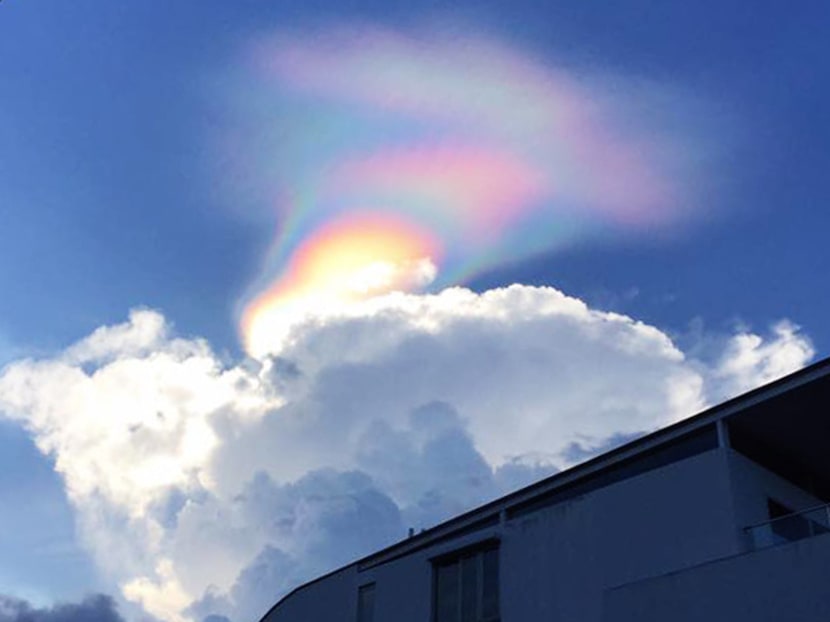Sorry Singapore, what you saw wasn't a ‘fire rainbow’
SINGAPORE — When a gorgeous multi-coloured glow lit up parts of the skies over the Republic on Monday (Feb 20), many media reports and netizens labelled the rare weather phenomenon a “fire rainbow”.

An iridescent cloud seen from Carmichael Road on Monday, Feb 20, 2017. Photo courtesy of Zhou Guang Ping
SINGAPORE — When a gorgeous multi-coloured glow lit up parts of the skies over the Republic on Monday (Feb 20), many media reports and netizens labelled the rare weather phenomenon a “fire rainbow”.
But the Meteorological Service Singapore (MSS) and a geography expert have told TODAY that the unusual sight was not a fire rainbow, or circumhorizontal arc as it is officially known.
Instead, what many Singaporeans saw was an iridescent cloud – a thin layer cloud formed when a humid layer of air above a low-level cumulus cloud is pushed upwards by the cotton-ball shaped cloud growing and rising.
“The phenomenon as reported in the media on February 20 2017 over Singapore was not a ‘fire rainbow’ but an iridescent cloud,” the MSS said in a written response on Saturday to queries from TODAY.
“The bright colours observed are due to diffracted sunlight around cloud water droplets. An iridescent cloud is not a circumhorizontal arc.”
A circumhorizontal arc, or fire rainbow, is an atmospheric optical phenomenon arising from the refraction of sunlight by ice crystals in high-level cirrus clouds, the MSS added.
In a video posted on social media earlier this week, TODAY wrongly labelled the weather sighting as a fire rainbow – a mistake which caught the attention of Assistant Professor Winston Chow of the National University of Singapore’s Department of Geography.
Dr Chow told TODAY that a circumhorizontal arc would require the sun to be above 58 degrees from the horizon. But when the first sightings of the multi-colour cloud phenomenon was reported around 5pm on Monday, the sun was only 33.65 degrees high.
He added that a circumhorizontal arc is formed when sunlight refracts off plate-shaped ice crystals parallel to the ground in cirrus clouds, which are thin, wispy, and high in the sky. Monday’s light show, however, was seen above a cumulus cloud.
“Usually, larger, more well-developed fire rainbows are in ice clouds like cirrus... which wasn’t the cloud type seen on Feb 20,” Dr Chow added. “Based on some of the images circulating on social media, there could be a cap (or Pileus) on top of the cumulus cloud, but that cap is likely to be composed of supercooled liquid rather than ice.”
This is evidenced by how the multi-colour glow at the cap of the cloud “wasn’t large but more patchy, suggesting the droplets or ice crystals weren’t uniform in size and that the cloud was still rapidly evolving at the time”, Dr Chow said.
Still, iridescent clouds can be considered a rare sight in Singapore. Its geographic proximity to the equator means there is only a very short lived window to achieve the conditions needed for an iridescent cloud, said Dr Chow.








